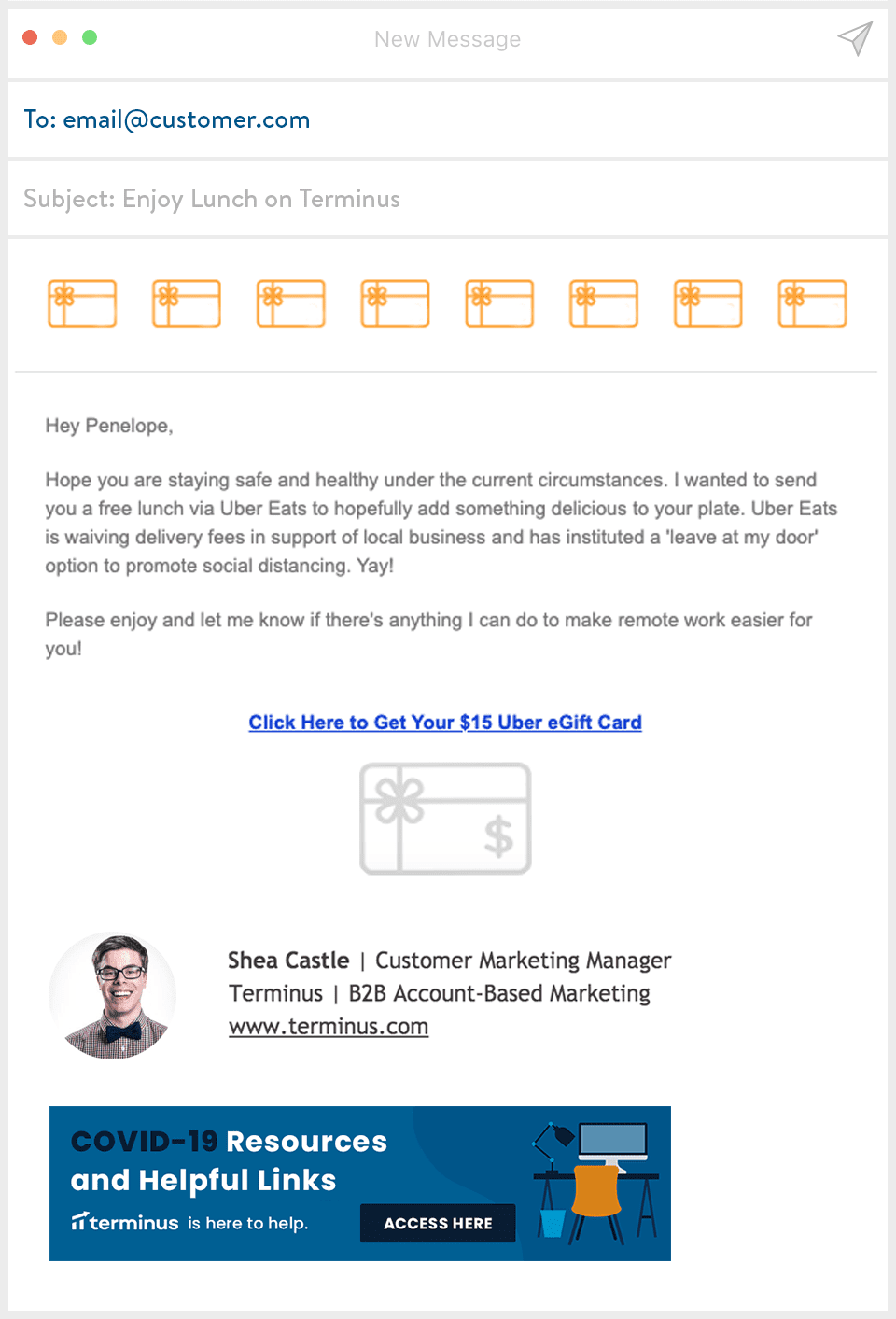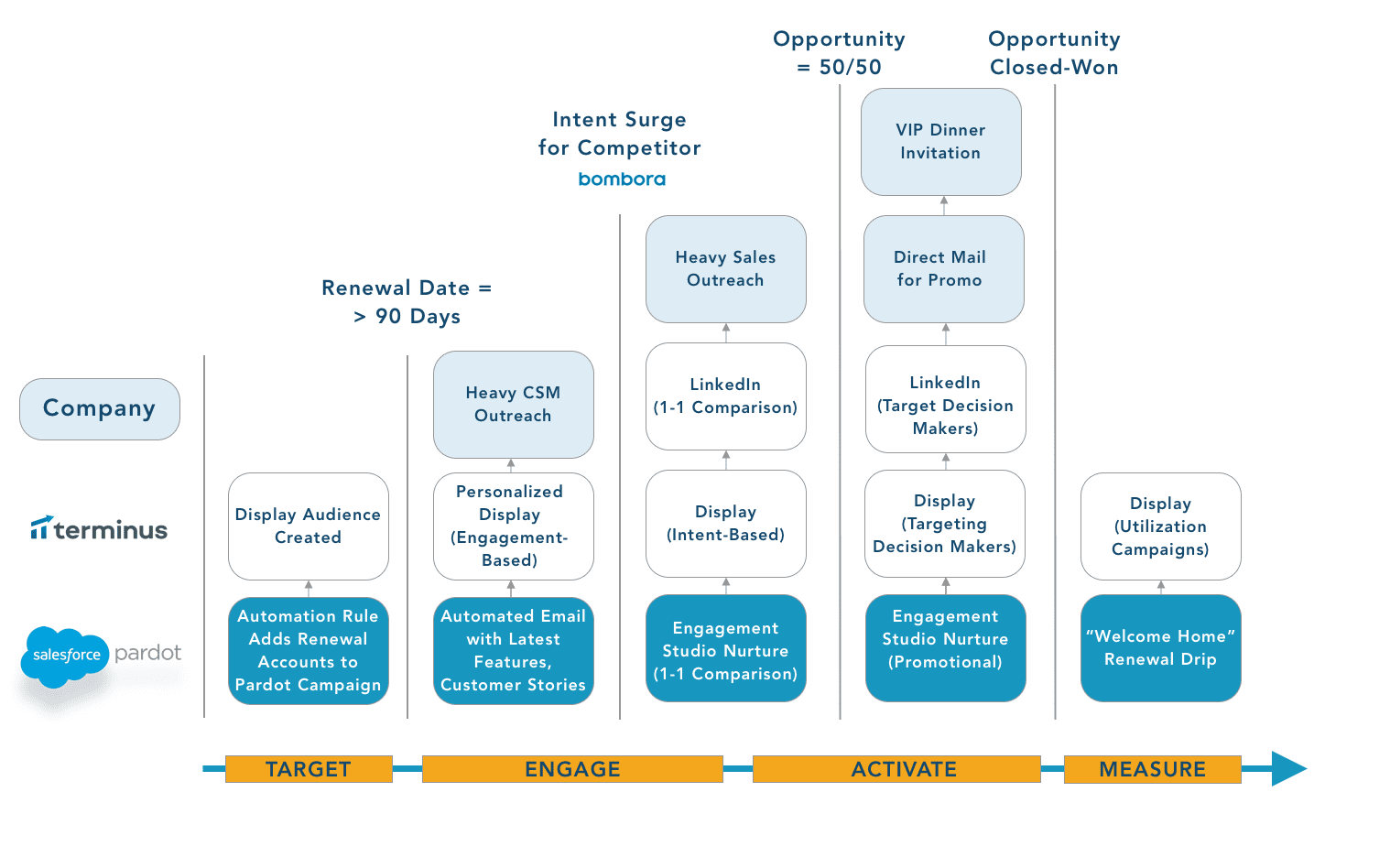As the world adjusts to the impact of COVID-19, customer retention and expansion programs are rising to the forefront of sophisticated business strategies for 2020. As capital markets become tighter, fewer new investments will be made and companies will need to reallocate resources to maintain their revenue targets. To help your company through this challenging time, Terminus has put together a few simple ideas to surprise, delight, and retain your key accounts.
1. Be a Helpful Resource (Even If It Doesn’t Relate to Business)
Whether it be a downturn, national crisis, or natural disaster, it can be a weird time for everyone. We’re all experiencing it together, and most of us probably aren’t sure how to act or what to do. So above all else, just be human. Be a resource, extend a helpful hand, or offer your time just to talk. Create helpful content relevant to the situation, even if it doesn’t relate to your business or service (we started with this simple list of resources and helpful links). Be sympathetic, relatable, and available to help, which in return will only strengthen your relationship with your customer.
2. Move On-Site Meetings to Virtual Meetings – with Food Delivery!
Before your now virtual meeting (which was once an on-site), send a gift card that allows your customer to choose a food delivery service they’re most comfortable with. Breaking bread is a big component of any interaction with a customer, so try a new and creative way to do the same with virtual meetings. Here’s an example of how we use Sendoso to deliver a free lunch to customers before an upcoming meeting.
3. Move Event Marketing Dollars to Targeted Digital Advertising
Face-to-face time with prospects or customers “on the road” is crucial to any business relationship. However, when that’s no longer an option, your team needs to act fast and creatively think of other ways to get your brand in front of your most important customers.
One quick win is to move some dollars from your event marketing budget to digital channels. The key? Don’t spray and pray. We’re talking smart, efficient, intentional targeted advertising (see our new ebook for more!) that ensures you reach your most important customers and keeps your brand top of mind. Tactically speaking, we recommend adding:
- Household extension targeting to your retargeting campaigns
- Expanding your cookie-based campaigns and reducing spend on IP-based campaigns to make sure you’re getting maximum return on investment in a remote working reality.
Cookie-based targeting is the best way to ensure your ads still reach your intended audience when they aren’t on the office IP, and household extension targeting lets you leap from work device to a personal device as the lines between both continue to blur.
4. Create Virtual Small Groups
Bring segments of your customers together digitally to talk about common challenges and brainstorm solutions. This can be by industry, region, company size, product utilization, etc. This will also open up new opportunities for your customers to connect with one another in the future. Building a community of like-minded customers allows them to feel a part of something, which in return boosts your chances of keeping a longtime customer.
5. One-To-One Direct Mail
This only works if your team members have strong relationships with customers and can get their home addresses, but this is a great time to send something non-perishable, thoughtful, or fun to make your customers feel less isolated.
A few ideas to get you started:
- Fun pair of socks (branded or customized specifically for the customer)
- Activity or game (if you know the customer has children)
- Uber Eats gift card
- Work-at-home essentials (like headphones or a paid Spotify subscription)
6. Create Engaging Video Content
During a downturn (like the one we’re all experiencing right now), your customers will have more time (most likely at home) to engage with training resources. How-to videos, demos of new features, and use case ideas are all types of video content that are perfect for virtual customer education. Here’s an example of how we used video to educate our customers on a new product feature (Account Insights).
https://play.vidyard.com/ozpTj2HTaiDjW9Aq1vqP7w.html
7. Help Them Plan Their Comeback
Pent-up buying activity will be hitting the streets (once we can actually go out on the streets again) and travel, retail, and other companies are going to want to make a roaring comeback. Help your customers plan and get excited to come back stronger than ever. Being there as a resource they can rely on during trying times will only strengthen your relationship as things get back to normal.
8. Add Competitor Brand Terms to Your Intent Topic List
In sports terms, playing offense sometimes may not be enough. Playing defense (or being prepared to play defense) is also important. First, create a list of your key customer accounts that are approaching their renewal date. Then go ahead and assume your competitors are already offering sweet deals to those customers (especially if new customer acquisition is a slowing trend in your industry). If you see a surge in intent for a competitor, your customer may be at risk of churning. With visibility on a metric like this, your team can get ahead of it or at least be prepared for an upcoming conversation.
Here is an example play that you might set up with both Terminus and Pardot, though any marketing automation platform (MAP) should function similarly (learn more in this Pardot blog post).
9. Update Your Target Account Lists with Expansion Opportunities
On the other side, while you pay attention to customers who may be at risk, also keep tabs on those who have upcoming expansion opportunities. A downturn or “tough times” may mean a loss of sales for some verticals, but for others (like virtual conference vendors and health manufacturers) it could result in a boom in business. Create a list of accounts that might see an increase in revenue this year and separate them from the rest of your customer base so your team can adjust marketing efforts accordingly.
10. Start Planning Your Winbacks Now
No one knows how this year will end up – but the facts are clear: this pandemic will end. If you do reach unfortunate circumstances where you lose a customer, there’s always a possibility you can win them back in the future. Offer them a plan or package for the following year, or start educating them on new product features and the roadmap. Find a way to look forward to the future and set a foundation for a future winback.

